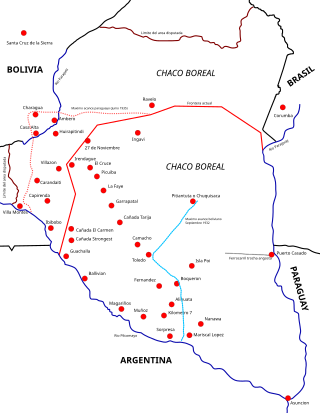
The Chaco War was fought from 1932 to 1935 between Bolivia and Paraguay, over the control of the northern part of the Gran Chaco region of South America, which was thought to be rich in oil. The war is also referred to as La Guerra de la Sed in literary circles since it was fought in the semi-arid Chaco. The bloodiest interstate military conflict fought in South America in the 20th century, it was fought between two of its poorest countries, both of which had lost territory to neighbours in 19th-century wars.
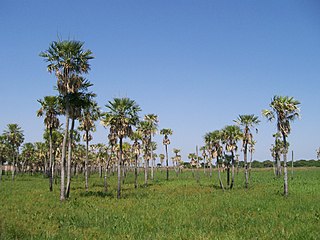
Chaco, officially the Province of Chaco, is one of the 23 provinces in Argentina. Its capital and largest city, is Resistencia. It is located in the north-east of the country.
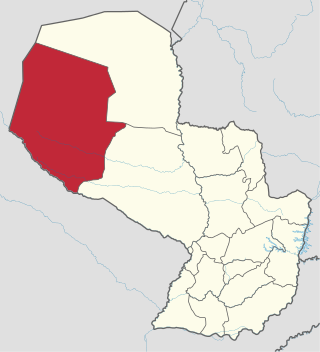
Boquerón is a department in the western region of Paraguay. It is the country's largest department, with an area of 91,669 km2 (35,394 sq mi), but, according to the statistics for 2021 by INE, its population is only 68,080, being the second least populated department. The department includes the Russian Mennonite colonies of Fernheim, Menno and its administrative center Loma Plata and Neuland. The capital is Filadelfia. Other towns are General Eugenio A. Garay, Doctor Pedro P. Peña and Mariscal Estigarribia.

Presidente Hayes is a department in Paraguay. The capital is the city of Villa Hayes. The department was named after U.S. President Rutherford B. Hayes, who awarded the territory to Paraguay while arbitrating a boundary dispute between Paraguay and Argentina after the Paraguayan War.
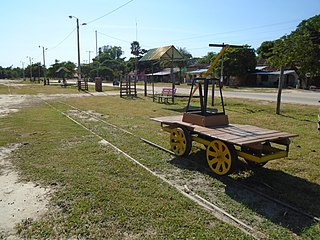
Puerto Casado is one of the 4 districts in Alto Paraguay Department, Paraguay. It includes the town of La Victoria or Puerto La Victoria, which has a population of around 7,800.

Ayolas is a city in the department of Misiones, Paraguay, located at 310 km southeast of Asunción, on the banks of the Paraná River. It is, also, the name of the district within which the city is located.

Villa Ángela is a city in the province of Chaco, Argentina, 186 km west of the provincial capital Resistencia. It is on the Gran Chaco, a lowland region of the Río de la Plata basin. It has 43,511 inhabitants as per the 2001 census [INDEC], making it the third largest in the province.
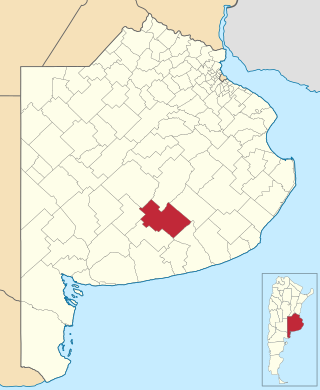
Benito Juárez is a partido in the south-central part of Buenos Aires Province in Argentina.
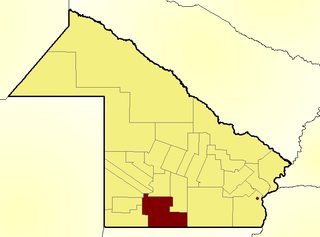
Mayor Luis Jorge Fontana is a southern department of Chaco Province in Argentina.
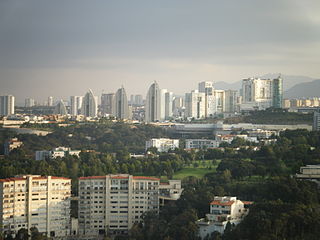
Huixquilucan Municipality is one of the municipalities in State of Mexico, Mexico. It lies adjacent to the west side of the Federal District and is part of Greater Mexico City but independent of Mexico City itself. The name "Huixquilucan" comes from Nahuatl meaning, "place full of edible thistles".

The General Manuel Belgrano Railway (FCGMB), named after the Argentine politician and military leader Manuel Belgrano, is a 1,000 mmmetre gauge railway and the longest of the Argentine system. It was one of the six State-owned Argentine railway companies formed after President Juan Perón's nationalisation of the railway network in 1948.

Province of Santa Fe Railway was a French-owned company that purchased a 1,000 mmmetre gauge railway network built by the provincial government of Santa Fe in Argentina on 10 April 1900 and later extended it in the provinces of Chaco and Córdoba. After nationalisation in 1948 it became part of the state-owned company Belgrano Railway
The Gran Chaco is a plain of about 1.000.000 km2. It covers parts of Bolivia, Paraguay, Brazil and Argentina.

Mapastepec is a town and municipality in the Mexican state of Chiapas in southern Mexico. Its name derives from the place name mapachtepec, "Hill of the Raccoon", a compound of the Nahuatl words mapachi ("raccoon") and tepetl ("mountain").

La Escondida is a village and municipality in Chaco Province in northern Argentina La Escondida in the region of Chaco with its 3,948 residents is located in Argentina - some 522 miles (840 km) north of Buenos Aires.
Pichanal is a town and municipality in Orán Department, located in northeastern Salta Province, Argentina. It is connected to the national road network by National Route 34, and to nearby San Ramón de la Nueva Orán by National Route 50. It has economic significance because of its position as a junction on these routes. It is within the bounds of the Yungas Biosphere Reserve.
The Forestal Land, Timber and Railways Company Limited, commonly known as La Forestal, was a British forestry company that operated in the region between the southern Chaco and northern Santa Fe provinces in Argentina. During the late 19th and early 20th centuries, La Forestal exploited the extensive quebracho forests in these provinces, becoming the leading global producer of tannin. The company played a significant role in establishing approximately 40 towns, constructed ports, laid down 400 kilometers of private railways, and operated around 30 factories. At its peak, La Forestal employed about 20,000 people.
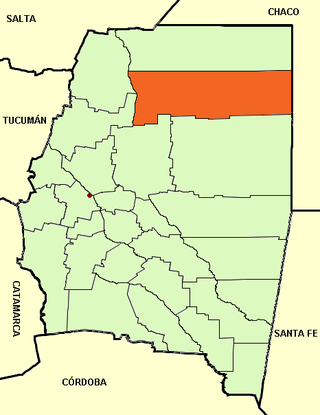
Alberdi Department is a department of Santiago del Estero Province, Argentina in the region of the Chaco Santiagueño. It is bordered on the north by Copo Department, on the east by Chaco Province, on the south by Moreno Department and Figueroa Department, and on the west by the Salado River which separates it from the Jiménez Department and Pellegrini Department. Its head town is Campo Gallo.
Paraje was a populated place along the east bank of the Rio Grande, in Socorro County, New Mexico, United States, now a ghost town. It is located north northeast of the Fra Cristobal Range.
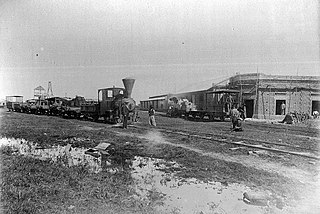
The Ocampo Railway, also called the first Chaco Railway and later La Forestal Railway, was the first railway of Villa Ocampo, of the North of Santa Fe and of the entire Gran Chaco Territory. It had a metric gauge (1000 mm) and was inaugurated on July 26, 1884. It was established by local settler Manuel Ocampo Samanés, who had also founded the city of Villa Ocampo in 1878.















